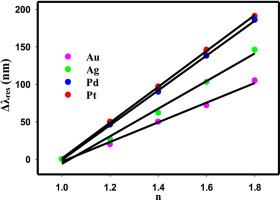Identifying optimal metals for plasmon-based sensing: Noble vs. non-noble candidates
IF 3
Q2 PHYSICS, CONDENSED MATTER
引用次数: 0
Abstract
The sensing capability of non-noble (Pd, Pt) and noble (Ag, Au) metals with respect to variations in size and local dielectric environment has been comprehensively investigated using the Finite-Difference Time-Domain (FDTD) method and the Drude–Lorentz model. The simulations confirm the crucial role of both the real and imaginary components of the metallic permittivity in determining the resonance condition and spectral response of nanoparticles to changes in particle dimensions and the host medium. A small variation in the real dispersion near the resonance wavelength, combined with a large norm of the permittivity, identifies Pt nanoparticles as highly reliable candidates for plasmon-based sensing devices. Among all examined metals, Pt also exhibits the lowest Quality Factor (QF), making its plasmon resonance the most sensitive to particle-size variations. In contrast, Au shows the weakest sensitivity to both particle size and the refractive index of the surrounding medium. These findings highlight the importance of incorporating non-noble metals into nanosensing platforms and provide practical guidelines for tuning nanoparticle photo-response through size, composition, and surrounding environment.

确定等离子体传感的最佳金属:贵金属与非贵金属候选物
利用时域有限差分(FDTD)方法和德鲁德-洛伦兹模型全面研究了非贵重金属(Pd, Pt)和贵重金属(Ag, Au)对尺寸和局部介电环境变化的传感能力。模拟结果证实了金属介电常数的实虚分量在决定纳米粒子的共振条件和对粒子尺寸和宿主介质变化的光谱响应方面的关键作用。共振波长附近实际色散的小变化,加上介电常数的大规范,确定了Pt纳米粒子作为等离子体传感器件的高度可靠的候选者。在所有被检测的金属中,铂也表现出最低的质量因子(QF),使其等离子体共振对颗粒尺寸变化最敏感。相比之下,Au对颗粒大小和周围介质折射率的敏感性最弱。这些发现强调了将非贵金属纳入纳米传感平台的重要性,并为通过尺寸、组成和周围环境调节纳米粒子的光响应提供了实用指南。
本文章由计算机程序翻译,如有差异,请以英文原文为准。
求助全文
约1分钟内获得全文
求助全文

 求助内容:
求助内容: 应助结果提醒方式:
应助结果提醒方式:


